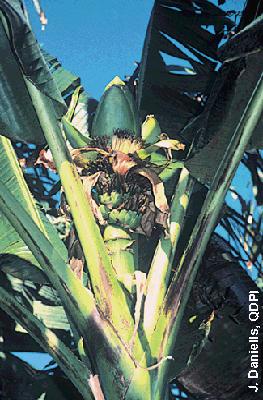Musa sections
The genus Musa is divided into two sections: Musa and Callimusa1 . A section is a taxonomic rank below the genus, and subgenus if present, and above the species. It is also above the series, but in the case of bananas the term series has been used interchangeably with section. In 2013, the number of sections in the genus Musa was reduced from 5 to 21 .
The majority of cultivated bananas are derived from species that belong to the Musa section, more specifically to the former Eumusa section, which has been merged with the Rhodochlamys section and renamed Musa2 . Fe'i bananas belong to the former Australimusa section, which has been merged with the Callimusa section and renamed Callimusa.
Early divisions
In 1887, the French botanist Paul Sagot published an article in which he subdivided the genus into three unnamed sections: i) the edible bananas, ii) the ornemental bananas with upright inflorescences and brightly coloured bracts, and iii) the giant enset species, which were later given their own genus3 .
A few years later, the 19th century botany John G. Baker defined three subgenera along the same divisions, which he respectively named Eumusa, Rhodochlamys and Physocaulis4 .
Modern sections
In 1947, Ernest Cheesman divided the genus into four sections based on chromosome numbers and morphological characteristics5 . He wrote that he deliberately called the groups sections rather than subgenera "in an attempt to avoid the implication that they are of equal rank". His grouping of species proved to be useful and was widely accepted.
Cheesman's sections
Cheesman divided the species with 11 pairs of chromosomes into two sections, Eumusa and Rhodochlamys. Among other characteristics, he described the species in this group as having convolute or more or less imbricated bracts that are rarely or never polished.
Cheesman split the species with 10 pairs into two sections, Australimusa and Callimusa. Among other characteristics, Cheesman described the species in this group as having strongly imbricated bracts that are polished on the outside.
Eumusa
In his key of the sections, Cheesman described the species in the Eumusa section as having, among other characteristics, dull-coloured bracts compared to the bright-coloured bracts of the species in the Rhodochlamys section. In addition to having dull-coloured bracts, the species in the Eumusa section are more than 3 meters high, have pendent or semi-pendent inflorescences and many flowers to a bract. The section includes the ancestors of the majority of cultivated bananas.
Rhodochlamys
Cheesman described the species in the Rhodochlamys section as being less than 3 meters high, having upright inflorescences, few flowers to a bract and brightly coloured bracts.
Callimusa
Although Cheesman said that Callimusa and Australimusa could also be split into dull-coloured and bright-coloured bracts, he believed that the most important distinction was the shape of the seeds, with Callimusa having a distinctive seed shape.
Australimusa
The shape of the seeds of Australimusa species is similar to those of species with 11 chromosome pairs. The section includes the wild species that gave rise to the Fe'i bananas.
Ingentimusa
In 1976, George Argent added the section, Ingentimusa for the lone species Musa ingens, which has 7 pairs of chromosomes6 .
Hakkinen's sections
A number of molecular analyses have since forced a rethinking of the sections7 8 9 10 11 12 . In 2013, the Finnish botanist Markku Hakkinen published a revision of the sections in which the Rhodochlamys section was merged into the Eumusa section and renamed Musa1 .
The Australimusa and Ingentimusa sections were merged into the Callimusa section. The new section kept the name Callimusa. It can be distinguished from the former by referring to it as follows: Musa sect. Callimusa Cheesman emend. Häkkinen13 .
At the time of the revision, the Musa section included 33 species and the Callimusa one 37.
Sections, as revised by Markku Hakkinen1
|
Musa
|
Callimusa
|
|---|---|
|
Musa acuminata
*Musa aurantiaca
Musa balbisiana
Musa basjoo
Musa celebica
Musa cheesmanii
*Musa chunii
Musa flaviflora
Musa griersonii
Musa insularimontana
Musa itinerans
*Musa kattuvazhana
Musa lanceolata
*Musa laterita
*Musa mannii
Musa nagensium
Musa ochracea
*Musa ornata
*Musa rosea
*Musa rubinea
*Musa rubra
*Musa sanguinea
Musa schizocarpa
Musa shankarii
*Musa siamensis
Musa sikkimensis
Musa thomsonii
Musa tomentosa
Musa tonkinensis
*Musa velutina
Musa yamiensis
Musa yunnanensis
*Musa zaifui
|
*Musa arfakiana
Musa azizii
Musa barioensis
Musa bauensis
Musa beccarii
*Musa boman
Musa borneensis
*Musa bukensis
Musa campestris
Musa coccinea
Musa exotica
*Musa fitzalanii
Musa gracilis
Musa haekkinenii
Musa hirta
+Musa ingens
*Musa jackeyi
*Musa johnsii
*Musa juwiniana
Musa lawitiensis
Musa lokok
*Musa lolodensis
Musa lutea
*Musa maclayi
Musa monticola
Musa muluensis
Musa paracoccinea
*Musa peekelii
Musa sakaiana
Musa salaccensis
Musa splendida
*Musa textilis
*Musa troglodytarum
Musa tuberculata
Musa violascens
Musa viridis
Musa voonii
|
A subsequent analysis of the maternally inherited chloroplast genome corrobated reducing the number of sections to two14 .
References
See also on this website
Musa sections revisited published 28 August 2013 in Under the peel, the blog of the ProMusa community

